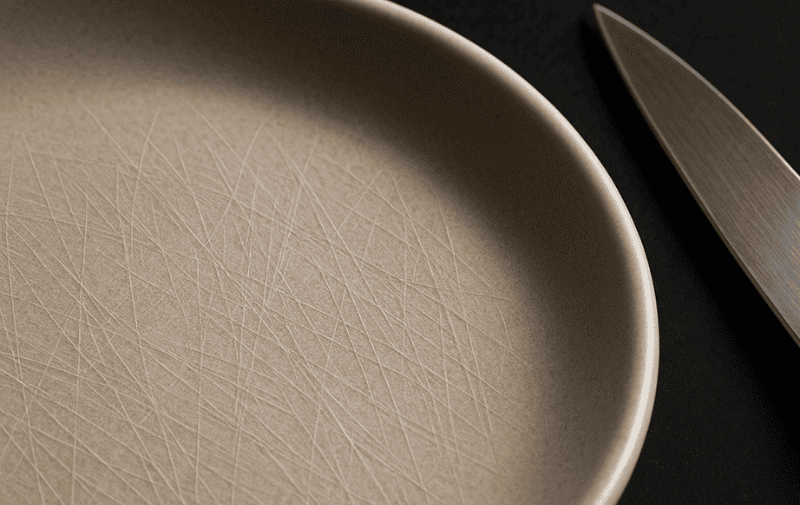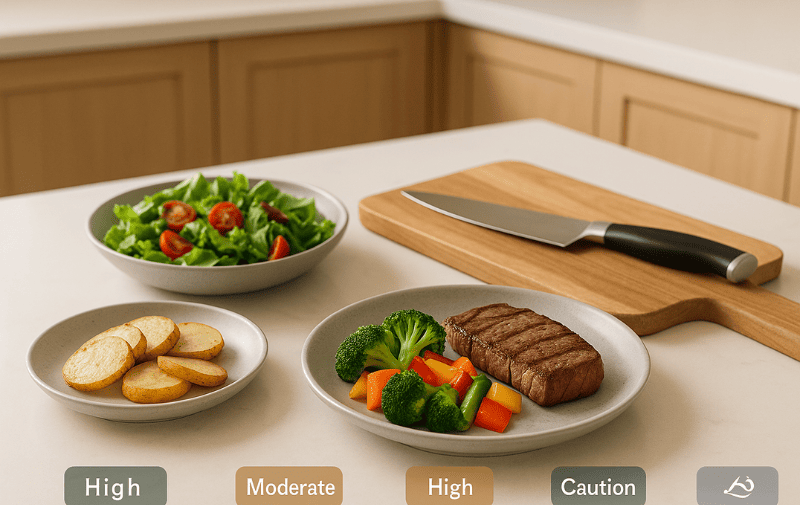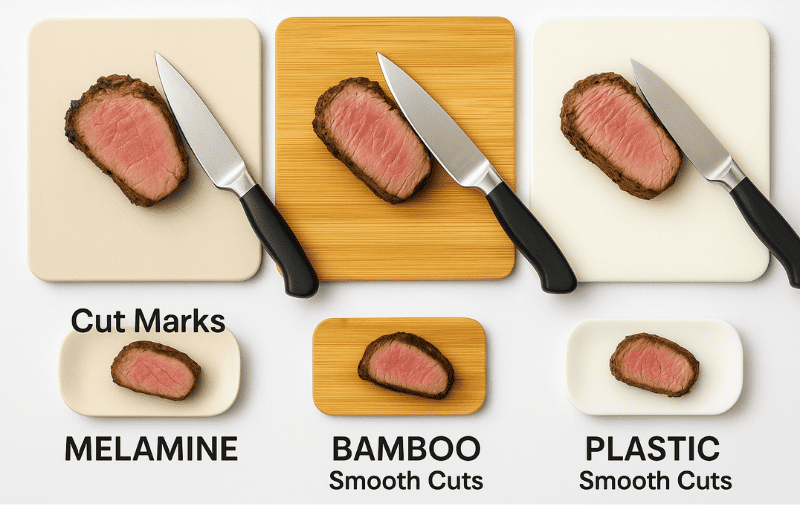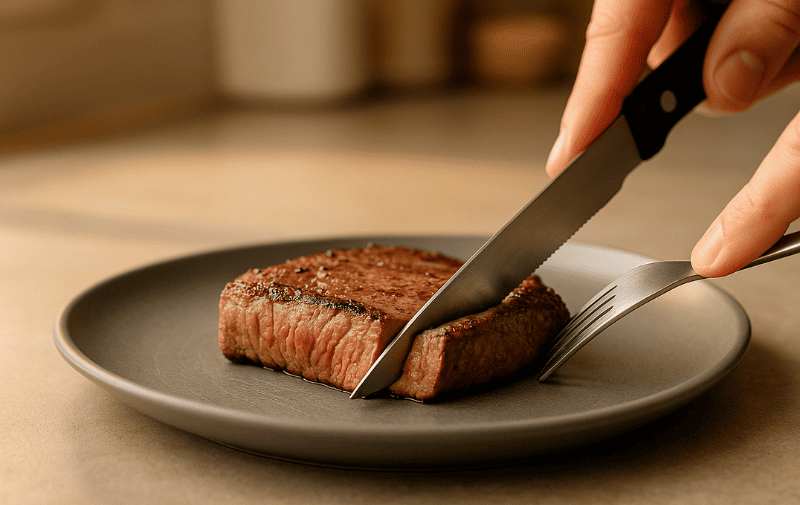You’re about to serve a beautiful steak on a new melamine plate, but you pause with the knife in hand. Will cutting on it leave a permanent, ugly scratch? Or maybe you’re in your workshop, staring at a large sheet of melamine, wondering how to cut it for your cabinet project without the edges chipping into a jagged mess.
Yes, you can cut on melamine plates with a butter knife, but a sharp steak knife will scratch the surface. To cut melamine boards for woodworking, you must use a special high-tooth-count saw blade and a specific technique involving scoring or painter’s tape to prevent chipping.
The question “Can you cut on melamine?” has two very different answers because it’s asked by two very different groups of people. As someone who works with melamine dinnerware every day, I see this confusion constantly. Let’s clear it up once and for all by tackling each question separately.
Last Updated: Aug 23th. 2025 | Estimated Reading Time: 12 Minutes

A Critical Clarification: Two Worlds of “Cutting Melamine”
Before we dive in, it’s crucial to understand which “melamine” you’re dealing with. The advice for one is completely wrong for the other.
This guide is split into two sections. Section 1 is for dinnerware—plates, bowls, and trays used for eating. Section 2 is for woodworking—large melamine-laminated boards used for furniture and cabinets.
Melamine Plates vs. Melamine Boards
| Feature | Melamine Dinner Plates | Melamine Woodworking Boards |
|---|---|---|
| What It Is | Dinnerware molded from 100% melamine resin. | Particleboard or MDF core with a thin, brittle melamine paper/resin top layer. |
| The User | Home cook, parent, restaurant owner. | DIY enthusiast, cabinet maker, woodworker. |
| The “Cutting” Tool | Dinner knife, steak knife. | Table saw, circular saw, jigsaw. |
| The Goal | To eat a meal without damaging the plate. | To get a clean, chip-free edge for construction. |
| The Main Concern | Scratches. | Chipping. |
Section 1: Using Knives on Melamine Dinner Plates
This section is dedicated to anyone who owns or uses melamine tableware in their home, restaurant, school, or hospital.
The Core Truth: Break-Resistant is NOT Scratch-Proof
This is the single most important concept to understand about melamine dinnerware. Its superpower is its incredible durability and resistance to shattering when dropped. However, this toughness does not translate to surface hardness.
Think of it like this: The screen on your smartphone might be highly scratch-resistant but will shatter if dropped. A high-quality melamine plate is the opposite: it’s highly shatter-resistant but can be scratched by a sharp object with enough force.
The Science of the Scratch: What You Are Actually Damaging
When you see a scratch on a melamine plate, you’re not just scuffing a piece of plastic. You are carving a trench through a sophisticated, layered surface.
| Layer of a Melamine Plate | Description | What Happens When You Cut It |
|---|---|---|
| 1. Protective Glaze | A clear, hard, fused top coat. | This is the plate’s armor. A sharp knife slices through this primary protective layer. |
| 2. Decorative Paper | The printed decal with the color or pattern. | Once the glaze is breached, the knife can tear or scrape away the ink on this layer. |
| 3. Melamine Body | The core molding compound of the plate. | A deep cut can dig into the core material, creating a noticeable groove. |
This damage is permanent and cannot be polished or buffed out.
A Tale of Two Knives: Why a Steak Knife is Melamine’s Enemy
The type of knife and the force you use are everything. Not all knives are created equal when it comes to your dinnerware.
| Knife Type | Action & Pressure | Impact on Melamine Plate | Recommendation |
|---|---|---|---|
| Butter Knife | Spreading with broad, low pressure. | No damage. The rounded edge is completely safe for the glaze. | ✅ Safe to Use |
| Standard Dinner Knife | Gently cutting soft, cooked foods. | Minimal risk. Can cause microscopic scratches over many years, but unlikely to cause visible damage with normal use. | ✅ Generally Safe |
| Steak Knife (especially serrated) | Slicing and tearing tough meat fibers with high, concentrated pressure. | High risk of damage. The sharp points of the serrations focus all your force, easily digging into and slicing through the glaze, leaving a permanent scratch. | ❌ Avoid at All Costs |
The Three Consequences of Cutting: More Than Just a Mark
A scratch on a melamine plate isn’t just an aesthetic problem. It has three practical consequences.
- Cosmetic Damage: The most obvious result is an ugly white or silver line that ruins the plate’s pattern and appearance. This is irreversible.
- Hygienic Risk: A new plate has a smooth, non-porous surface that is very hygienic. A deep knife scratch creates a trench that can trap food particles, oil, and bacteria, making the plate harder to sanitize completely. This is a major concern in commercial food service.
- Compromised Durability: The protective glaze is the plate’s primary defense. Once it’s breached, the printed design underneath is exposed to detergents, acidic foods, and abrasion, which can cause the print in that area to fade or stain over time.
Pro Tip: Matte-finish melamine dinnerware is significantly better at hiding fine, unavoidable scratches than high-gloss melamine. This makes it a smarter and more durable-looking choice for high-use environments like restaurants or family homes.

The Professional’s Verdict and The Steakhouse Rule
So, the final answer: No, you should not cut on melamine plates, especially with steak knives.
For restaurants, caterers, and even home users who love the durability of melamine, we have a simple guideline: The Steakhouse Rule.
The Steakhouse Rule: If the meal requires a steak knife, it requires a ceramic plate.
For restaurants, the solution is simple: serve pre-sliced steak on the beautiful melamine plate, or serve the steak on a classic porcelain plate. For home use, simply swap out your melamine for ceramic when you’re serving steak or other tough cuts of meat. Following this one rule will dramatically extend the life and beauty of your melamine dinnerware collection.
Section 2: How to Cut Melamine Boards Without Chipping
This section is for woodworkers, cabinet makers, and DIY enthusiasts working with melamine-faced particleboard (MFP) or MDF.
Why Does Melamine Chip So Easily When You Cut It?
The challenge of cutting melamine boards comes from their construction. You have a brittle, hard resin coating (the melamine) laminated onto a softer, more pliable wood composite core (particleboard or MDF). When a standard saw blade rips through it, the upward motion of the teeth violently smashes into the brittle bottom surface, causing it to chip and tear out.
The Secret Weapon: You Need a Special Saw Blade
A standard wood-cutting blade will destroy your melamine board. You need a blade specifically designed for laminates and melamine.
- High Tooth Count: Look for a blade with a high number of teeth (e.g., 80 teeth for a 10-inch blade). More teeth mean smaller, cleaner “bites.”
- Special Tooth Geometry: The best blades have a Triple-Chip Grind (TCG) or a High-Alternate Top Bevel (Hi-ATB) tooth configuration. These are designed to shear the material cleanly rather than tear it.
The Best Technique for a Perfectly Clean Cut: A Step-by-Step Guide
Having the right blade is half the battle. The right technique is the other half.
- Apply Painter’s Tape: Firmly apply a strip of high-quality painter’s tape along your cut line on both the top and bottom surfaces. This helps hold the melamine surface together and significantly reduces chipping.
- Score the Cut Line: This is a crucial professional step. Set your table saw or circular saw blade to be very shallow—just enough to cut through the top layer of melamine (about 1/16″ or 1-2mm deep). Make a first, shallow “scoring cut” along your line.
- Set the Final Blade Height: Raise the blade so that the tips (gullets) are just slightly above the thickness of the material you are cutting. This creates a downward cutting angle, which is cleaner.
- Make the Final Cut: With the board firmly supported, make the final cut, following your scored line. Use a steady, consistent feed rate—not too fast, not too slow.
- Use a “Zero-Clearance Insert”: On a table saw, using a zero-clearance insert supports the wood fibers right next to the blade, giving you the cleanest possible cut on the bottom side.

Conclusion: The Right Tool for the Right Melamine
The answer to “Can you cut on melamine?” is a clear and simple “it depends.”
- For Melamine Plates: Treat them with care. Use them for serving, not as a cutting board. Avoid steak knives at all costs to preserve their beauty and hygiene for years to come.
- For Melamine Boards: Treat them with precision. Use a specialized, high-tooth-count blade and a careful, multi-step technique to achieve the flawless, chip-free edge your project deserves.
Frequently Asked Questions (F.A.Q.)
1. Are scratched melamine plates safe to eat from?
Generally, yes. The material itself is stable. The main concern is hygiene, not chemical leaching. A deep scratch can harbor bacteria if not cleaned properly. If a plate becomes heavily scratched, it’s best to replace it, especially in a commercial setting.
2. Can you repair scratches on a melamine plate?
Unfortunately, no. Once the protective glaze is cut, the damage is permanent. There are no food-safe fillers or polishes that can effectively repair a scratch on a melamine surface.
3. Why do restaurants use melamine plates if they can scratch?
Restaurants use them because their primary advantage—being virtually unbreakable—saves them a huge amount of money in replacement costs from dropped plates. The cost savings from preventing breakage far outweighs the risk of occasional scratches, which can be managed with proper food handling (like following the Steakhouse Rule).
4. What is the absolute best saw blade for cutting melamine boards?
The industry gold standard is a blade with a Triple-Chip Grind (TCG) profile and a high tooth count (80T or more for a 10″ blade). Brands like Forrest, Freud, and CMT make blades specifically advertised for cutting melamine and laminates.
5. Can I cut a melamine board with a jigsaw or handsaw?
It is not recommended if you need a clean edge. Both a jigsaw (with its upward cutting stroke) and a handsaw will cause severe chipping on the melamine surface. They should only be used for rough cuts where the edge will be hidden or covered.
6. I chipped the edge of my melamine shelf. How can I fix it?
For small chips, you can use a color-matched seam filler or laminate repair paste. For larger chips along an edge, the best solution is to cover the edge with peel-and-stick edge banding, which is available in various colors and wood grains.
Recommended:
The Best Shatter-Proof Dinnerware for Families and Restaurants
Wood Magazine – Tips for Cutting Melamine



